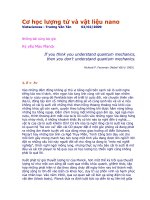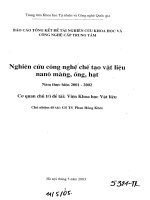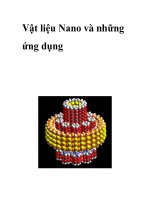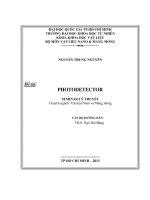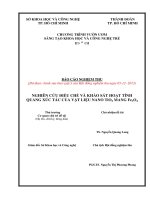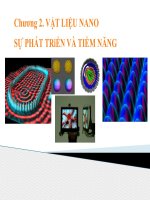Slide vật liệu nano và màng mỏng liga process
Bạn đang xem bản rút gọn của tài liệu. Xem và tải ngay bản đầy đủ của tài liệu tại đây (1.32 MB, 22 trang )
.c
om
cu
u
du
o
ng
th
an
co
ng
LIGA process
CuuDuongThanCong.com
/>
.c
om
High Aspect Ratio Molding
cu
u
du
o
ng
th
an
co
ng
LIGA process is used for high aspect ration molding;
typical Materials are Ni, NiCo
• Micromachining; typical Materials are Brass, Al
alloys
• Si Micromachining; typical Materials Si, Ni
• Combination of Various Techniques Followed by
Electroplating: Ni, NiCo
CuuDuongThanCong.com
/>
LIGA process
.c
om
• LIGA
– German term
co
an
th
du
o
ng
– Also called DXRL (Deep Xray lithography)
– XRL
ng
• Lithographie,
Galvanoformung,
Abformung
Lithography,
electroplating, molding
cu
u
• MEMS: Very thick
structures using high
energy
Source : IMM, Institut für Mikrotechnik mainz Gmbh
CuuDuongThanCong.com
/>
LIGA examples
.c
om
High aspect ratio microstructures
(HARMs)
u
du
o
ng
th
an
co
ng
– Thickness: ~2 mm
– Aspect ratio: > 10:1
cu
•
CuuDuongThanCong.com
/>
UV-LIGA process
• UV-LIGA
.c
om
Cr mask
Polymer
ng
co
th
Electroplating
of metal
u
– Polyimide
du
o
• Low aspect ratio (< 1:1)
• ~40 m thick
Polymer
mold
ng
• Polymer as electroplating mold
– PR
Seed
layer
Substrate
an
– Standard UV lithography
– UV-sensitive polymeric resists:
+ve PR, -ve PR (SU-8 epoxy,
polyimide, thick photoresist)
– Multi-layer possible
– Cost-effective compared to LIGA
(Also called LIGA-like or poor
man’s LIGA)
UV light
cu
• Low aspect ratio (< 3:1)
• ~80 m thick
Electroplated
metal
– SU-8 epoxy
• High aspect ratio (~10:1)
• ~ 500 m thick
CuuDuongThanCong.com
Positive resist
Negative resist
/>
.c
om
Examples of UV-LIGA processed SU-8
Tilted SU-8 exposure
ng
20 m
UV light
cu
u
du
o
ng
th
an
co
110 m
CuuDuongThanCong.com
31.6o
/>
.c
om
Mold Inserts
cu
u
du
o
ng
th
an
co
ng
Basic requirements
• Low mechanical stiction and friction
• No deviation from vertical sidewalls ( no
undercuts )
• Avoid surface oxidation
Chemically inert
Smooth surfaces
Defect free sidewalls
Homogeneous material properties
CuuDuongThanCong.com
/>
Molding
• Molding
co
ng
.c
om
– Low cost massive
production of precise plastic
parts using LIGA or UV-LIGAprocessed metallic mold
inserts
th
cu
u
du
o
ng
– Molten plastic is injected
onto a metallic mold insert
– Heated above glass
transition temperature (Tg)
of the plastic
– Polymers
an
• Injection molding
ã PE, PP, PC, PMMA, COC, or
biodegradable polymers
(e.g. RESOMERđ)
CuuDuongThanCong.com
/>
.c
om
General Design Rules for Mold
cu
u
du
o
ng
th
an
co
ng
• Round the corners where the polymer will
shrink onto the metal
• Avoid patterning numerous aspect ratios in
one sample (ie. Use AR that deviate +/- 2
from the average AR in the pattern)
• Centralize the patterns that are most
critical.
Deviation further from center are more
difficult to emboss
CuuDuongThanCong.com
/>
.c
om
General Design Rules for Mold
cu
u
du
o
ng
th
an
co
ng
• Sidewall quality is critical
– Surface roughness > 500 nm
– Perpendicularity >85° with >2 °
center bowing
• Bottom surface quality less critical
– Surface roughness > 10 mm
CuuDuongThanCong.com
/>
Common Molding Materials
co
ng
.c
om
POM
Poly(oxy methylene),
Tm = 156°C (Copolymer), Tproc 180°C
Tm = 175°C (Homopolymer)
Low friction, good impact strength,
critical
decomposition into formaldehyde,
critical
cavitation due to crystallization
mechanical applications (gear wheels)
PSU
Poly(sulfone),
Tg 190°C, Tproc 250°C
Transparent, high strength
for use at higher temperatures up to
180°C,
microfluidic pump
cu
u
du
o
ng
th
an
PMMA
Poly(methyl methacrylate),
Tg 100°C, Tproc 170°C-210°C
Transparent, brittle, sensitive to
crack
optics, lost mold for production of
metallic
microstructures
PC
Poly(carbonate),
Tg 148°C, Tproc 180°C-200°C
Transparent, good hardness and
impact strength
optics, medical
CuuDuongThanCong.com
/>
Injection molding system
LSU
du
o
ng
th
an
co
ng
.c
om
Source: www.osha.gov
cu
u
Injection molded
plastic toys
www.toysrgus.com
CuuDuongThanCong.com
/>
PDMS molding process
– Microelectronics compatible silicone
elastomer, durable, optically transparent,
and inexpensive
10:1 pre-polymer and
curing agent
Metallic mold
insert
Substrate
ng
• Process
.c
om
• PDMS (polydimethyl siloxane)
co
– A mixture of PDMS pre-polymer and a
curing agent cast or spin-coated onto
master molds
– Cured at 100 C for ~1 hour (65 C for 4
hours)
– Replicated PDMS peeled off from master
molds
• Advantages
du
o
ng
th
an
Desiccator
cu
u
– No need of expensive equipment such as
injection molding and hot embossing
machines for polymer replication
– Low temperature processing for curing
PDMS (65 C)
Removal of air bubbles
Vacuum
Pump
CuuDuongThanCong.com
Replicated PDMS
HARMs after curing
/>
ng
PDMS Casting
Attachment of
PDMS to Si
co
Ni or SU-8 Mold
Replicated
PDMS Mold
.c
om
PDMS replication and pattern transfer process
Electroplated Ni &
PDMS removal
th
an
Application : massive replication of precision PDMS microstructures, pattern
transfer of MEMS components on circuit
20 m
m 300
m
300
m
cu
u
du
o
300
m
ng
20
m
300
m
20 m
Ni mold
20 m
300
m
Replicated PDMS
CuuDuongThanCong.com
/>
Stereolithography (SL)
• Stereolithography
.c
om
– Repeatedly print layers that become part of a final microstructures
– Freeform 3D structures made of polymers
• Optical energy is focused and locally hardens a photopolymer
cu
u
du
o
ng
th
an
co
ng
– Rapid prototyping
– Low cost
– No integration w/ electronics
CuuDuongThanCong.com
/>
cu
u
du
o
ng
th
an
co
ng
.c
om
Micro SL examples
CuuDuongThanCong.com
Source: /> />
Miscellaneous micromachining techniques
.c
om
• EDM (Electro-discharge
machining)
– Also called spark machining
co
an
du
o
ng
th
– Used for unusual designs in
hard, brittle metals
ng
• Metal is locally removed by
high frequency electrical
sparks
Source:
/>EResnews/0601/sf/sf_4.html
u
• LCVD (Laser-assisted
chemical vapor deposition)
cu
– Energy needed for deposition
is provided by photons
– Complex 3D structures
rice
• Adjusting the focal point of
the laser continuously
CuuDuongThanCong.com
A 7-mm car fabricated by precision machining
/>
.c
om
cu
u
du
o
ng
th
an
co
ng
Packaging Technology
CuuDuongThanCong.com
/>
ng
cu
u
du
o
ng
th
an
co
• Wafer bonding
• Plasma bonding
• Anodic bonding
• Adhesive bonding
.c
om
Bonding techniques
CuuDuongThanCong.com
/>
Wafer bonding
co
ng
A technique to create cavities or channels
Joint wafers together to provide hermetic sealing
Bond similar or dissimilar substrates permanently
Various bonding techniques are used
u
du
o
ng
th
an
• Anodic bonding, fusion bonding, eutectic bonding, glass frit bonding, ….
cu
–
–
–
–
.c
om
• Wafer bonding technique
CuuDuongThanCong.com
/>
IC vs. MEMS packaging
ng
co
du
o
ng
– MEMS devices are mostly
freestanding and moveable
– Non-standardized process
an
• MEMS packaging
th
– ICs are 2D planar devices and
immoveable
– Standardized process
– Well established mass
production technology
– 1/3 ~2/3 of the total
manufacturing cost
.c
om
• IC packaging
cu
u
• Packaging requirement
different from one MEMS
device to another
– Easily takes up 2/3 or more of
the manufacturing cost for
initial commercialization
CuuDuongThanCong.com
/>
cu
u
du
o
ng
th
an
co
ng
.c
om
TI DLP packaging process
CuuDuongThanCong.com
/>

